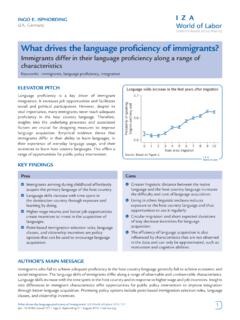Transcription of itil quick guide.htm Copyright © tutorialspoint
1 - quick REFERENCE GUIDEITIL - quick REFERENCE GUIDEITIL OverviewITIL is a framework providing best practice guidelines on all aspects of end to end servicemanagement. It covers complete spectrum of people, processes, products and use of a day s itil is being practiced by almost every company providing IT services to processes, tasks and checklists described in itil are not organization-specific, butcan be implemented by any organization. It gives organization a framework to plan,implement and measure IT was published in 1989 by Her Majesty's Stationery Office HMSO in UK onbehalf of the Central Communications and Telecommunications Agency CCTA,now subsumed within the Office of Government Commerce itil is required? itil helps business managers and IT managers to deliver services to the customers in effectivemanner and hence gaining the customer s confidence and satisfaction. Here are the areas whereITIL plays an effective role:IT and business strategic planningIntegrating and aligning IT and business goalsImplementing continuous improvementAcquiring and retaining the right resources and skill setsReducing costs and the Total Cost of OwnershipDemonstrating the business value to ITAchieving and demonstrating Value for Money and Return on IT organization effectiveness and efficiencyDeveloping business and IT partnerships and relationshipsImproving project delivery successManaging constant business and IT changeITIL VersionsITIL was originated as collection of books.
2 These books of itil cover all aspects of IT servicemanagement. Since its origin, it has undergone many changes which lead to the following versionsof itil : itil V1 was the initial version of itil consisting of 31 booksFrom 2000 to 2004, itil V1 was revised and replaced by 7 books ITILV2. This versionbecame globally accepted and is now used in many countries by thousands of organizationsIn 2007, itil v2 was modified and consolidated with 3rd version of itil , consisting of five corebooks covering the service lifecycle. itil V3 included 26 processes and 4 functionsIn 2011, the 2011 edition of V3 was published. It was an updated version released in PublicationsITIL core publications include a set of five manuals: Service Strategy, Service Design, ServiceTransition, Service Operation and Continual Service of ITILF ollowing diagram shows several benefits of itil : itil V2 vs. itil V3 itil V2 ITILV3 Focused on product, process and on product, process, people oriented approachLifecycle based management is part of evaluationSecurity management is a separateprocessEmphasizes on service design and servicestrategyEqual attention to all processesHave 10 processes and 2 functionsHave 26 processes and 4 BasicsServiceService is a means of delivering value to customers by achieving customer's desired results whileworking within given vs.
3 ProductServicesProductsServices are not are are produced and consumedat same are not produced and consumedat same are are user participates in the productionof user doesn t participate in theproduction of ManagementService Management refers to all aspects of the management of IT service provision. Accordingto itil , Service management contains all organizational capabilities for generation of added valueto the customers as of Service ManagementHere are the main goals of Service management:Make IT services adaptable towards the present and future requirements of an organizationand its customersDevelop and maintain good & responsive relationship with the businessMake effective and efficient use of all IT resourcesOptimizing the quality of delivered servicesReduction of long term cost of service deliveryAchieving Service ManagementHere are the key activities needed to be performed in order to achieve business and customer ssatisfaction:Service LifecycleThe complete framework of itil is based on service lifecycle.
4 Each lifecycle defines certainprocesses for effective service lifecycle helps to amplify the service management approach and to achieve betterunderstanding of its structure. In the coming chapters, we will be discussing all lifecycleindividually with their processes and and FunctionsThere are 26 processes and 4 functions in itil V3. These processes and functions are discussed indetail with each service lifecycle in further defines policies, standards, guidelines, activities, and work instructions. A process takessome defined inputs to produce desired function is defined as group of people or tools required to carry out one or more processes Strategy OverviewService Strategy helps to design, develop and implement service management as organizationalcapabilities and strategic assets as well. It enables a service provider to consistently outperformcompetitive alternatives over time, across business cycles, industry disruptions and changes strategy comprises of the following key concepts:Value creationService AssetsService Provider typesService structuresDefining the service marketDeveloping service offeringsFinancial managementService portfoliosDemand managementReturn on investmentStrategic AssessmentBefore crafting service strategy, a provider should first take a careful look at what it does following questions can help expose a service provider s distinctive capabilities:Which or our services or service verities are the most distinctive?
5 Which or our services or service verities are the most profitable?Which of our activities in our value chain or value network are the most different andeffective? factors in Strategic AssessmentHere are the key factors that play important role in strategic and weaknessesThe attributes of the organization. For example resources and capabilities,service quality, skills, cost structures, product knowledge, customerrelationship StrategyThe perspective, position, plans and patterns are received from a Success factorsHow will the service provider know when it issuccessful? and opportunitiesIncludes competitive thinking. For example, isthe service provider vulnerable to substitution?, or Is there a means tooutperform competing alternatives?Value CreationService strategy defines a unique approach for delivering better value. According to customersservice consist of two elements:UtilityWarrantyUtilityUtility is perceived by the customer from the attributes of the service that have positive effect onthe performance of task associated with the desired business outcomes.
6 This is fir for is generally stated in terms of:Outcomes supportedOwnership costs and risks avoidedWarrantyWarranty ensures the utility of the service is available as needed with sufficient capacity,continuity, and security. Value of warranty is communicated in terms of level of is usually defined in terms of availability, capacity, continuity, and securityof the utilization of the AssetsThere are two types of service assets as listed below:ResourcesCapabilitiesResourcesReso urces are the inputs for production. The resources are transformed by management,organization, people and refer to skills to develop and control the resources for production. The skills are basedon knowledge, experience and Provider TypesService Provider can be broadly classified into three types as described below:Type I Internal Service ProviderInternal Service provider refers to the business functions within an organization. Administration,finance, human resources, and IT service providers all comes under internal service II Shared Service ProviderIn this, business functions such as IT, human resources, and logistics are consolidated into anautonomous special unit called a Shared Service Unit III External Service ProviderExternal service provider refers to the third party service providers.
7 It can offer competitive pricesand drive down unit cost by consolidating Four Ps of strategyThe below mentioned Four Ps identify the different forms of a service strategy and are consideredas entry points to service strategy processesThe following diagram expresses the different processes and their relationship in service strategy:Service Strategy RolesThere are several roles that are responsible for managing different key aspects of ServiceStrategy. Here we will discuss all of the roles in this good relationship with customersIdentifies customer s needsEnsures service provider meet customer s needWorks closely with Service Level for understanding, anticipating, and influencingcustomer demand for servicesWorks with capacity manager to ensure that service providerhas sufficient capacity to meet the required for accounting, budgeting, and SteeringGroup ISGSets direction and strategy for IT servicesReviews the business and IT strategies in order to make surethat they are alignedSets priorities of service development PortfolioManagerDecides on a strategy to serve customers in cooperation withISGD evelops service provider s offering and StrategyManagerWorks with ISG in producing and maintaining the serviceprovider s strategyResponsible for communicating and implementing servicestrategyStrategy GenerationFor positive results, service provider needs to plan his services strategically.
8 A good servicestrategy defines a unique approach for delivering better Strategy Manager is the process owner of this Generation Sub processesStrategy Management comprises of four activities as listed below:Defining the marketDeveloping offeringsDeveloping strategic assetsMeasuring and Preparation for implementation of strategyDefining the marketIt is necessary to take survey of services available in the market. It gives a clear perspective of costand quality of services already present and what new service can be offered in offeringsIn this service provider develops a portfolio which contain all the services that are visible andavailable for the customer. Service portfolio is developed in order to represent all binding serviceinvestments towards the strategic assetsIt deals with buying new technologies, resources and capabilities to offer law-cost and high-valueservice to the and Preparation for implementation of strategyIn order to measure success or failure of the strategy, all critical success factors are the completion in the market is observed and priorities areService Portfolio ManagementService PortfoliosService portfolio contains description of all the services engaged throughout the service also represents the commitment and investment made by service provider across all customersand market catalogue is subset of service portfolio and contains presently active servicesin service operation phase.
9 We will discuss service catalogue in detail as part ofservice design portfolio management ensures that the service provider is offering right combination ofservices to meet the customer s Portfolio Manager is the process owner of this purpose of service portfolio management is to provide answer to the following questions:Why should customer buy this service?Why should they buy from us?What form does the pricing structure take?What are our strengths and weaknesses, priorities and risks?How should we apply our resources and capabilities?Sub ProcessesService portfolio management includes sub processes as shown in the following diagram:DefineThe purpose of this process is to define desired results of a purpose of this process is to analyze the impact of proposed new service or changed serviceon existing services in service purpose of this process is to submit change proposal to change management and to initiatethe design stage for the new or changed service if change proposal is purpose of this process is to communicate decisions, allocate resources and charter Relationship ManagementBusiness Relationship Management generally includes:Managing personal relationships with managersProviding input to Service Portfolio ManagementEnsuring that IT service provider is satisfying the customer s needBusiness Relationship Manager is the process owner of this Relationship Management includes following sub-processes.
10 Maintain Customer RelationshipIdentify Service RequirementsSign up customers to Standard ServicesHandle Customer ComplaintsMonitor Customer ComplaintsCustomer Satisfaction SurveyMaintain Customer RelationshipThis process ensures that service provider understands customer s need and set up relationshipswith new potential Service RequirementsThis process ensures that service provider have complete understanding of output of a service andto decide if the customer s need can be fulfilled using an existing service offering or if a newservice needs to be up customers to Standard ServicesThis process deals with customer requirements and service level Customer ComplaintsThe objective of this process is to record customer s complaints and take corrective action Customer ComplaintsThe objective of this process is to monitor the processing status of customer s Satisfaction SurveyThe objective of this process is to identify the scopes where customer expectations are not ManagementDemand Management is very important and critical process in service strategy.
















